Pruning Terms
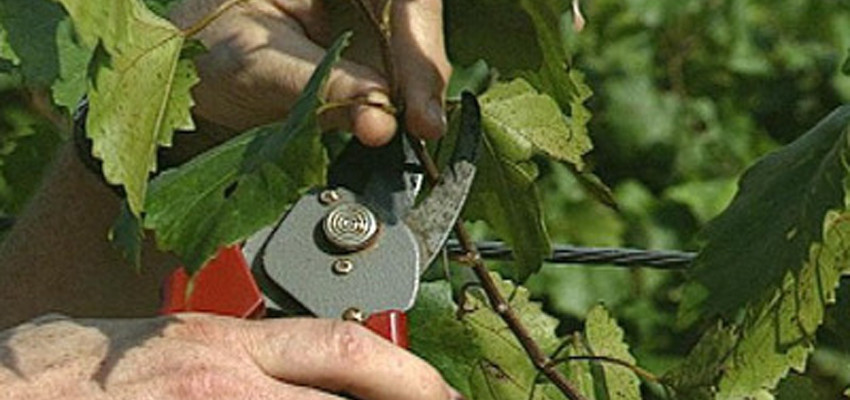
Be sure to check out our full line of pruning products!
Arms. The main branches or extensions of the trunk.
Bud. The slightly enlarged portion in the node region of a cane from which shoots grow.
Canes. Shoots that are mature and have attained all or most of their full length. They may be devoid of leaves and dormant. Dormant canes are previous season’s annual growth.
Capacity. The degree of a vine’s ability to produce fruit and wood.
Disbudding. The removal of swollen buds or young shoots less than 1 inch long.
Fruiting wood. Canes or spurs that are selected for their size and quality and cut back to bear the current year’s crop.
Head. The part of the trunk, usually at the tip, from which branches or arms grow.
Internode. The portion of a shoot or cane between two nodes.
Laterals. The side branches of a shoot or cane.
Node. The joint or swelling on a shoot or cane where buds and leaves are found.
Old Wood. Wood on any part of a vine older than one year.
Pinching. The removal of the growing tip of a shoot by pinching between thumb and finger.
Pruning. The removal of excess parts of a vine above ground– canes, shoots, and leaves.
Renewal spur. A spur that produces shoots for the next year’s fruiting canes or spurs.
Shoots. The new green growth that develops from buds during the growing season and matures to form canes.
Spur. The basal portion of a cane after it is cut back to a length of 1 to 4 buds. ( The basal bud near the point where the cane joins an arm is not counted.)
Suckers. Shoots growing from below the surface of the ground.
Thinning. The removal of flower clusters, immature fruit clusters, of their parts.
Training. The direction or form given to a young vine as it grows, usually by attaching it ti a mechanical support.
Trunk. The main body or stem of a vine.
Grow Tubes FAQs
We carry TUBEX Vinegro Grow Tubes »
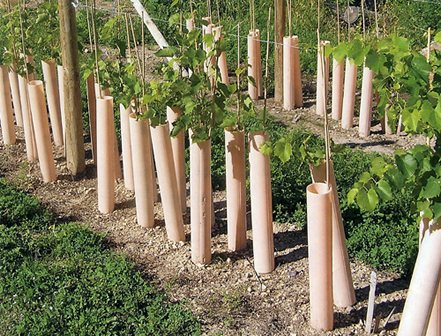
Photo courtesy of Duane & Martha Hubbs, Honey Hill Vineyard, WI
Even though tens of millions of grow tubes have been used successfully in vineyards throughout the world, there is still a great deal of confusion surrounding their benefits and proper use.
As with so many tools, the rule of thumb with grow tubes is simply:
- A good quality grow tube (properly used) creates cost savings and revenue increases far in excess of the cost of the tube. It multiplies the bottom line.
- A poor quality grow tube (or a good quality grow tube improperly used) does not create cost savings or revenue increases, and does little or nothing for the bottom line.
To help clear up the confusion, and help you get the most out of this proven technology, here are answers to some of the most Frequently Asked Questions about grow tubes:
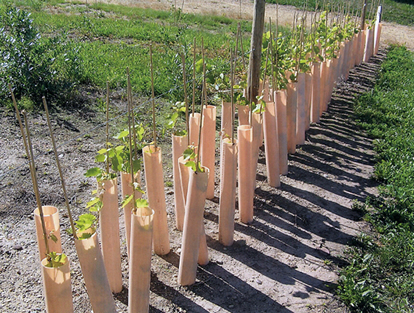
Photo courtesy of Duane & Martha Hubbs, Honey Hill Vineyard, WI
What are the benefits of using grow tubes?
Grow tubes offer grape growers several time- and money-saving benefits*:
1) Faster establishment of balanced, healthy vines – Grow tubes – good quality, large diameter grow tubes – accelerate the growth of both stems and roots, resulting in an increase of total vine biomass. This means:
· Your first commercial crop – the first ‘black ink’ entry you get to make in your ledger – comes sooner
· The period of time needed to ramp up to mature crop levels is reduced
2) Protection from herbicide spray makes weed control – the biggest challenge to Midwestern and Eastern grape growers – faster, easier, and more effective – No searching for vines amidst the weeds, no herbicide or mechanical cultivator damage to vines. For commercial growers, grow tubes dramatically reduce labor costs. For hobby growers with a limited number of man-hours to devote vineyard maintenance, grow tubes are indispensable.
3) Reduced vine training costs – Grow tubes automatically train vines to grow upward toward the cordon wire, saving several trips through the field to train vines. Again, this reduces labor costs for commercial growers and allows hobby growers to use their limited time for more productive activities – like weed control!
4) Protection from animal predation – Grow tubes protect newly planted vines from deer, rabbits and other rodents.
5) Increased vine survival under windy or drought conditions – Grow tubes – good quality, large-diameter grow tubes – reduce the moisture stress on newly planted vines, resulting in very high survival rates. This dramatically reduces the number of replants necessary. Replants are extremely expensive because their care and maintenance needs (weed control, training, spraying, etc.) are out of sync with the rest of the vineyard, and of course replants reduce the productivity of the vineyard until all vines reach maturity.
* These benefits result only from the use of large-diameter, high quality grow tubes.
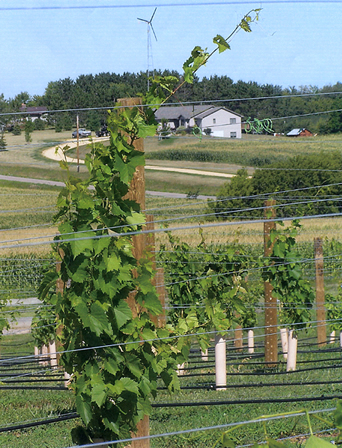
Photo courtesy of Duane & Martha Hubbs, Honey Hill Vineyard, WI
What are the disadvantages of using grow tubes?
There are no disadvantages when using large-diameter, good quality grow tubes.
Good quality, large-diameter grow tubes do, of course, increase the up-front investment for vineyard establishment. However, the savings from easier weed control, reduced vine training, faster establishment of healthy vines and reduced replanting far outweigh the cost.
Small diameter grow tubes, on the other hand, can adversely affect vine establishment. These tubes might cost less, but a cost with no associated benefit (or even a negative impact) is not a savings at all.
What are some things I should avoid in a grow tube?
1) Triangular or square shape. The flat surfaces of these shapes rapidly absorb heat when the sun’s rays hit them flush at certain times of day.
2) Small diameter & 3) Green color. Small diameter tubes prevent leaves from deploying at optimal angles for sunlight absorption and photosynthesis. Green tubes create an environment rich in green light. Both types of tubes cause the same set of problems. The vine gets the same sensory feedback as if it was surrounded by vegetative competition. In other words, the vine “thinks” it is surrounded by other plants (either physically pressing against it as with small diameter tubes, or reflecting green light as with green tubes).
All plants, grapevines included, respond to vegetative competition the same way: They allocate nearly all of their growth resources to ‘primary’ growth – growing taller – in order to gather more sunlight and to cast shade on surrounding plants. They allocate almost no resources to ‘secondary’ growth – stem thickness and root development.
Why bother developing thick stems and strong roots if surrounding plants are going to hog all the sunlight? The result: Tall, thin-stemmed grapevines.
What are the features I should look for in a grow tube?
1) Circular shape. Triangular and square designs absorb more heat at certain times of day when the sun’s rays are flush with a flat surface of triangular or square tubes. With a circular tube only a small portion of the tube is ever facing the sun’s rays directly, reducing the absorption of heat.
2) 3.5 inch diameter. Research shows grow tubes that are 3.5 inches in diameter dramatically increase total vine biomass production. Tubes of 3.5 inches in diameter produce 70% more total vine biomass, with thicker stems, and balanced root/shoot ratios.
3) Opens from the side. Grow tubes are left in place until after the vine is trained to the cordon wire. A well-designed grow tube allows you to remove it for re-use without untying the vine.
4) Pink/beige color. This color optimizes the ratio of light frequencies plants need for photosynthesis. This color gives vines the same sensory feedback as being in full sunlight, so that they allocate growth resources to ‘secondary’ growth – stem thickness and roots.
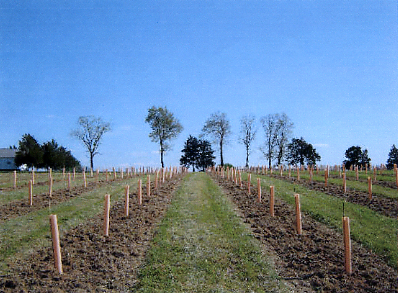
Photo courtesy of Monarch Hill Vineyards, St. Genevieve, MO
—————————————————————-
I have heard that grow tubes produce vines with thin, spindly stems. Is this true?
NO! – for large diameter, good quality grow tubes.
Research conducted at CSU Fresno showed conclusively that large-diameter (3.5 inches), good quality, pink/beige grow tubes produce vines with:
- Thicker stems
- 70% more stem dry weight (the most accurate measure of biomass growth)
- 70% more root dry weight
- The same healthy, balanced root/shoot ratio as the (much smaller!) vines without grow tubes
The myth of spindly-stemmed vines has persisted for two reasons:
1) Too many growers have used small diameter, triangular, or green grow tubes, have seen the thin-stemmed vines these tubes typically produce, and have mistakenly assumed that all grow tubes cause these problems.
2) Growers in regions where irrigation is used have occasionally over-watered their vines, which can inhibit growth.
For the thousands of growers who have used large-diameter, good quality grow tubes (and have used them properly) the results are universal: Bigger, healthier, balanced vines that bear fruit sooner and reach mature production levels faster.
I have heard that grow tubes reduce root development. True or false?
FALSE – for large-diameter, good quality grow tubes.
Circular grow tubes with a diameter of 3.5 inches produce vines with 70% more total biomass – 70% more stem weight AND 70% more root weight – in exactly the same, healthy root/shoot ratio as the (much smaller!) vines grown without tubes.
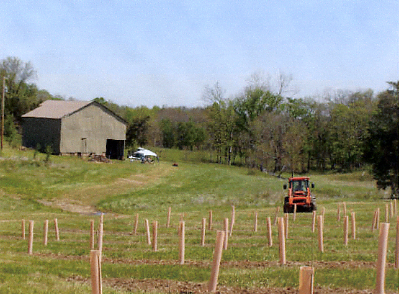
Photo courtesy of Monarch Hill Vineyards, St. Genevieve, MO
Should I re-apply grow tubes in the spring of the second year (before second leaf) in order to get another season of herbicide protection?
It is highly recommend that you remove grow tubes in autumn. Because vines in grow tubes are under far less stress, the period of active growth extends farther into the late summer and early fall. This can leave the vines more vulnerable to frost damage. This can be completely prevented by removing the grow tubes in early to mid-September.
If your extension agent or viticultural expert recommends re-applying grow tubes the following spring, follow this recommendation. The grow tubes will have little to no further beneficial effect on growth (having increased balanced biomass growth by 70% or so in first leaf), but they will continue to provide protection from herbicide spray, dramatically reducing the man-hours required to maintain the vineyard.
Controlling Birds In Your Vineyard
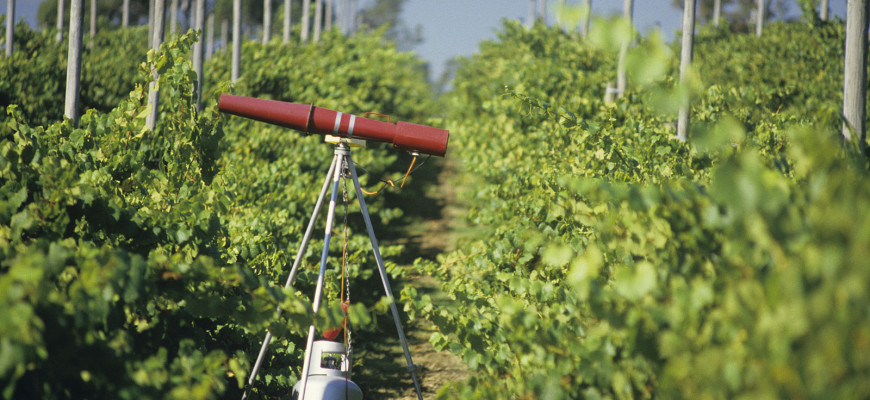
If you are feeding birds on your property, stop now. Birds will soon be returning from warmer climates, will start mating, and will build nests near a food supply. As their young grow, they will be taught about the food sources nearby.
As you go through your vineyard this spring, pruning and tying, remove any bird nests nestled among your grapevines!
Be aware of potential perching areas close to your vines. You may need more deterrents in these areas. These would be woodsy areas where birds can seek shelter and shade, fly out and eat grapes, then fly back for nighttime roosting.
As migratory birds return to your area, be observant as you spend time in your vineyard. What species of birds are hanging around? What hawks are in your area? This information will be important when it comes time to selecting deterrents.
BIRD CONTROL IN AUGUST and SEPTEMBER
Bird migratory behavior is starting. This means feeding changes for your resident birds, as well as new birds coming through your area. Flocks of birds are looking for a ready food source to keep them going as they migrate. Resident birds have produced more young, which are either being fed and introduced to your crop, or have learned and have formed their own feeding groups. It is sometimes hard to identify species of young birds (especially at a distance), as they have not fully acquired their adult plumage.
If by any chance, you still have bird feeders out, even empty ones will attract the attention of birds migrating. Your resident birds will continue to check feeders, as long as they’re up.
Are you using drip irrigation? Dripping water will attract birds. Robins especially are appreciative of this feature, as it also enables them to locate earthworms, should they desire a break from your fruit. If you can safely irrigate at times when birds are less likely to be around, that may help. Drought areas in your state will cause more aggressive bird feeding behavior, as they need moisture as well as food.
Whatever method of bird control you’re using needs stepping up at this time, and continue through harvest.
Bird distress units should have chips changed, speakers relocated, or speakers added. Add a visual deterrent to give the birds a focus – they look for what is causing the distress.
Be sure that your distress unit is working every day. Broken wires, dead batteries, and lightning strikes can cause problems with your unit. If you’re using a battery, consider getting a second battery for backup. Keep one charged, and the other powering your distress call unit.
We keep battery cables, adapters, extra speakers, a variety of recording chips, and the Bird Gard units themselves on hand, in case of emergency.
If you are using visual scare only, relocate those, add something new, change visuals, or add an auditory scare. Even audio tapes with loud sounds can be played. Try the sound track from Gettys- burg, or other tapes with gun sounds or loud noises.
For robins, put some scare items closer to the ground. Once they get down on the ground and under the canopy, they tend to ignore scare items above the crop. Suggestions from growers also include audio tape draped over the crop & fishline strung under the canopy and closer to the ground as a barrier.
If you’re using bird net, be sure that it is secured at the sides and bottom, especially if robins are your problem. They can get up underneath your net and eat your fruit. If you need help on bird identification or suggestions on what to do, we will be happy to assist you!

